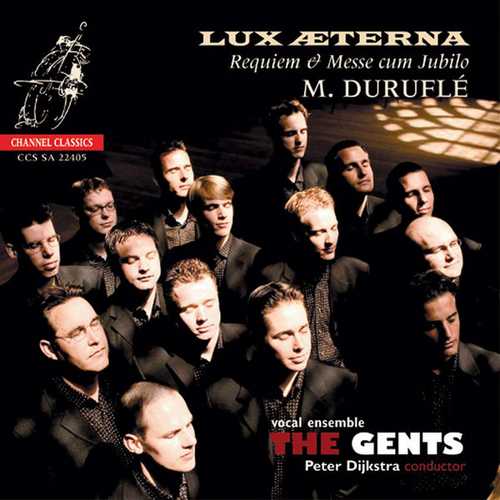
Composer: Maurice Duruflé, Francis Poulenc, Olivier Eugène Prosper Charles Messiaen
Performer: The Gents
Conductor: Peter Dijkstra
Format: FLAC (tracks)
Label: Channel Classics
Release: 2018
Size: 2.39 GB
Recovery: +3%
Scan: yes
Maurice Duruflé:
Requiem, Op. 9
01. Introitus
02. Kyrie
03. Domine Jesu Christe
04. Sanctus
05. Pie Jesu
06. Agnus Dei
07. Lux æterna
08. Libera me
09. In paradisum
10. Notre Père, Op. 14
Francis Poulenc:
Quatre petites prières de Saint François d’Assise
11. Salut, Dame Sainte
12. Tout Puissant Tout Puissant Tout Puissant
13. Seigneur, je vous en prie
14. O mes tres chers freres
Maurice Duruflé:
Messe Cum Jubilo, Op. 11
15. Kyrie
16. Gloria
17. Sanctus
18. Benedictus
19. Agnus Dei
Francis Poulenc:
Laudes de Saint Antoine de Padoue
20. O Jesu
21. O Proles
22. Laus Regi
23. Si Quæris
Olivier Eugène Prosper Charles Messiaen:
24. O sacrum convivium
Maurice Duruflè Requiem Op. 9 (1947) dedicated to his father in memoriam. The Requiem is Maurice Duruflè greatest and most imposing work. He received the commission for it from his publisher while he was still at work on a Suite for organ. The movements of this Suite were based on Gregorian melodies, and were ideally suited for further expansion and transformation into a Requiem Mass of respectable dimensions. The Requiem of Gabriel Faur undoubtably served as a model for this work. The choice of texts is identical (largely consisting of portions of the Liturgia Defunctorum), but Durufl introduces a break between the Introit and Kyrie, and also between the Lux Aeterna and Libera me. The result is a Requiem in nine movements, whereas with Faur there are no more than seven. ….. Messe cum Jubilo Op. 11 (1966) dedicated to his wife, Marie-Madeleine Durufl. Interest in Gregorian chant underwent a real renaissance during Durufls youth– the activities at and surrounding the abbey of Saint Pierre de Solesmes played an essential part in this, but that is another story– and this interest can be sensed, as it can in the Requiem, in the Messe cum Jubilo. The indication cum iubilo is the subtitle of the 9th Kyriale of the Mass ordinary as it can be found to this day in the Graduale Triplex (Solesmes 1979). In contrast to the Requiem, the powerful melodic line of this mass is left unaltered in each of the five movements, in the sense that the harmony, which seems to spring effortlessly from the modal character of the melodic progression, is left completely to the orchestra or organ.